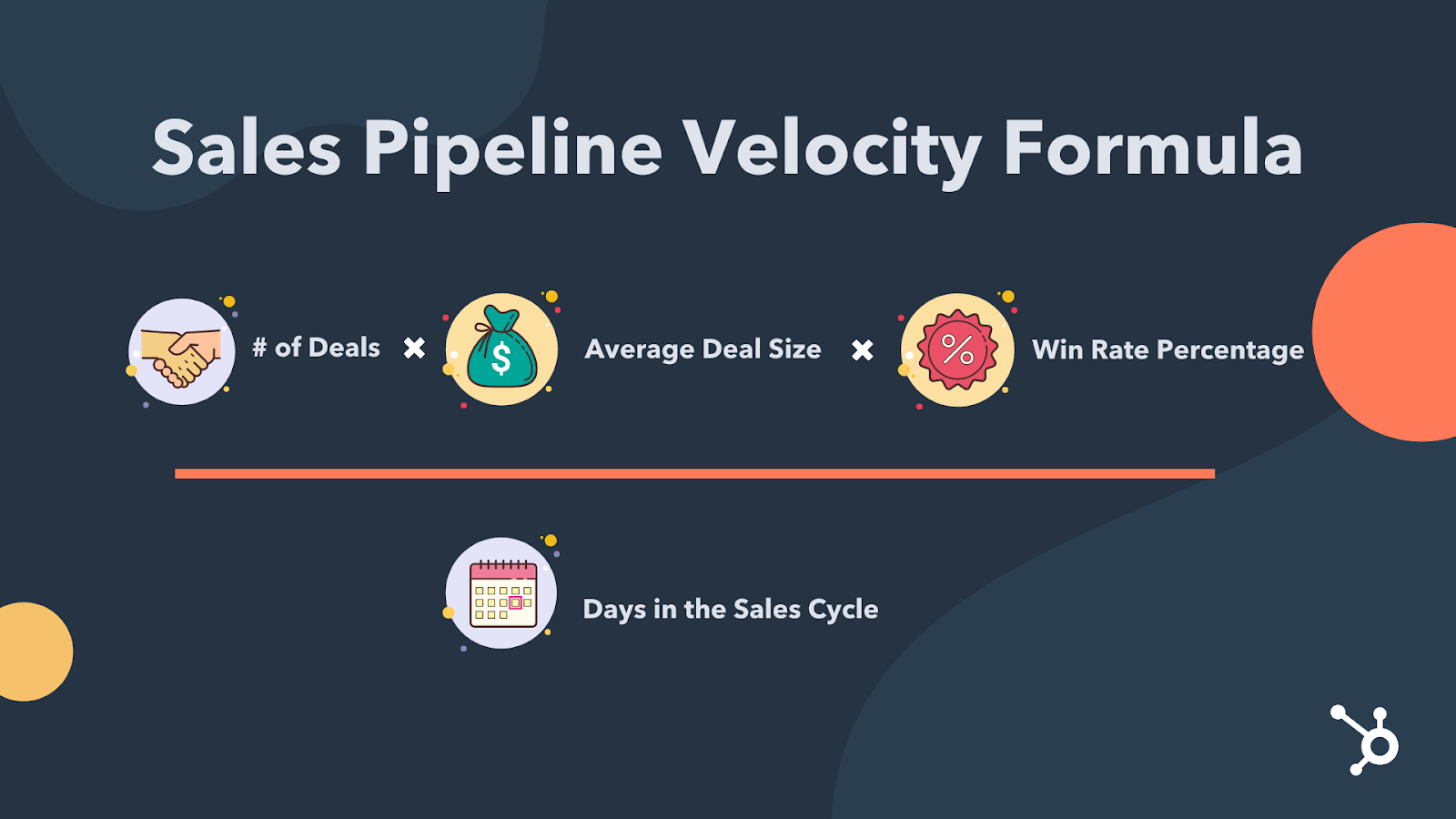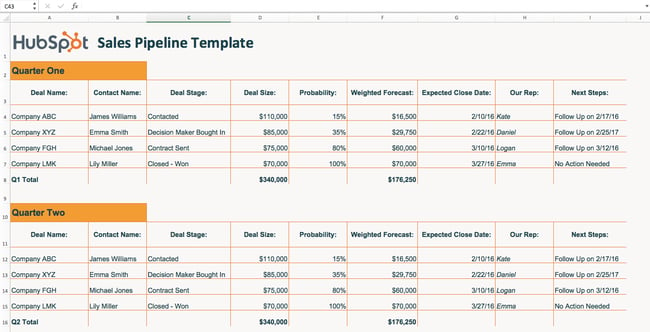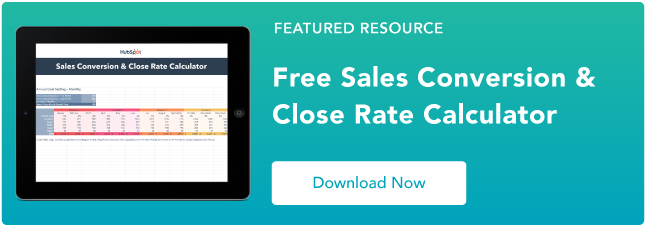The more control and visibility you have of your sales pipeline, the more revenue you’ll bring in.
In fact, HubSpot Research found a positive relationship between the number of opportunities in your pipeline per month and revenue achievement. The more opportunities in your pipeline, the more likely you are to reach or exceed your revenue goals.
Growing a healthy sales pipeline is possible through careful assessment and thoughtful pipeline management.
But what is a sales pipeline? And why is it so instrumental to successful sales? In this guide, you’ll learn everything you need to know about sales pipeline management, including:
Image Source
Because sales processes are different for every company (and even for products within the same company), your sales pipeline should be unique and reflect the typical buyer’s journey.
The sales pipeline allows sales reps and managers to forecast revenue by looking at what stage of the sales process prospects are in and predicting how many of them will close as deals during a given timeframe.
Every prospect will move through the sales pipeline at a different rate depending on factors like their level of interest, urgency, and how much research they’ve done about a product or service. Certain prospects may even skip stages in the pipeline. For example, if a buyer proactively introduces you to the budget authority before you’ve asked, you’d move the deal straight from “initial connect” to “meeting with the decision-maker.”
![Download Now: Sales Conversion Rate Calculator [Free Template]](https://no-cache.hubspot.com/cta/default/53/059a7eef-8ad9-4bee-9c08-4dae23549a29.png)
Sales Pipeline vs. Sales Forecast
People often confuse “sales pipelines” with “sales forecasts.”
A sales pipeline includes every opportunity a salesperson is handling (no matter how new or mature it is) Reps use them to keep track of where prospects are in the sales process and inform the appropriate actions they should take.
A sales forecast, on the other hand, is an estimate of the opportunities likely to close in a given time period. It shows salespeople and sales managers how closely they’re trending toward their goals and helps them prepare for what’s to come.
If your forecast anticipates you’re going to miss your quota, you should double down on selling activities. If your forecast shows you’re on track to make 150% of your quota, on the other hand, you’d want to scale back your efforts for this month and start laying the groundwork for an equally successful next month.
Sales Pipeline vs. Sales Funnel
People also often use “sales pipeline” and “sales funnel” interchangeably. However, a sales funnel suggests that the number of prospects you’re working with will drop off as the sales process continues.
This metaphor reinforces the incorrect idea you need three times as many prospects at the top of your funnel as the bottom. A sales manager following this philosophy would ask his rep to connect with 300 buyers to close 100 deals.
Instead, think about it like a wide-brimmed champagne glass — as coined by sales educator and expert Jeff Hoffman. You may have a ton of prospects entering your pipeline, but the vast majority should drop off after the qualification stage. After prospects have passed the critical point, most should become customers.
The most successful reps often have 1.25x or 1.5x the ratio of opportunities to deals in their sales pipelines.
How long does it take to build and develop a sales pipeline? The answer depends on your product, base, sales team, and marketing resources.
Here are the basic steps to building a sales pipeline.
1. Define the stages of your sales pipeline.
While the quickest way to define your sales pipeline stages might be copying a template, it’s worth the time and effort to develop your own.
After all, the stages of the pipeline must match your prospect’s buying journey to effectively help you track progress and predict revenue.
Review the typical process your customers go through.
- Awareness: The buyer realizes they have a pain point or opportunity.
- Consideration: The buyer defines their paint point or opportunity, develops evaluation criteria and needs, and researches potential approaches.
- Decision: The buyer has finalized their strategy and is now comparing vendors/specific solutions.
To illustrate, check out this hypothetical buyer’s journey:

With that in mind, your sales pipeline stages might be:
- Connect: The buyer engages with your company, whether they open an email from a salesperson, attend a webinar, or download a piece of content.
- Appointment set: The buyer agrees to a meeting to learn more about how you can help them.
- Appointment completed: They showed up to the meeting, and you confirmed the next steps.
- Solution-proposed: The buyer is interested in using your product to solve their pain point or capitalize on their opportunity.
- Proposal sent: The buyer reviews your proposal or contract.
The more complex your product, the longer your sales cycle will take — and the more stages there may be.
2. Identify how many opportunities typically continue through each stage.
You should know how long prospects spend in each stage — both across the board and for closed/won deals. For example, maybe the average prospect spends two weeks in the demo stage, while prospects that eventually buy spend three weeks.
Knowing these benchmarks will help your reps and sales managers predict which opportunities are most likely to close.
You also should know the percentage of opportunities that typically advance to the next stage.
Moreover, it’s critical to establish yield probability (or conversion rate) per stage. Perhaps prospects are 75% likely to buy in the demo stage and 90% likely to buy in the negotiation stage. Once you’ve assigned these percentages to each stage, you can develop monthly and/or quarterly revenue estimates.
3. Calculate the number of opportunities you need at each stage to hit your goals.
Now you can work backward to determine how many opportunities you need in each stage of your pipeline. Start with your target monthly or quarterly revenue divided by your average deal size. That tells you how many deals you need to win in a month or quarter.
Next, divide your target deal number by your yield probability per stage. If you need to win 135 deals, and your reps typically close 90% of deals in the negotiation stage, 150 opportunities must reach that stage in a month.
Repeat this process for every stage. Once you have total milestones, you can divide these goals by salesperson.
Here’s an example from Bob Marsh, CEO of LevelEleven. Assume you need 2,000 deals per year to hit your target bookings.
- 2,000 deals / year = 167 deals per month
- 8,000 proposals / year = 667 proposals per month
- 32,000 meetings / year = 640 meetings per week
- 64,000 calls / year = 256 calls per day
If you have a 100-person team, that translates to:
- 167 deals per month / 100 reps = 2 deals per month
- 667 proposals per month / 100 reps = 7 proposals per month
- 640 meetings per week / 100 reps = 7 meetings per week
- 256 conversations per day / 100 reps = 3 calls per day
Salespeople can use these benchmarks to objectively measure their progress against the goal.
However, keep in mind every rep’s conversion rates will vary by stage. If one of your salespeople struggles to prospect but has an excellent demo-to-close rate, they’ll need to have fewer initial meetings than their peers to meet the quota.
4. Understand the commonalities between opportunities that convert at each stage of your pipeline.
Next, pinpoint the common characteristics of opportunities that convert for every stage. These include both the actions each rep takes (like sending a follow-up email) and prospect responses (agreeing to a demo).
This qualitative is just as helpful as quantitative data to shape your goals and understand repeatable behaviors — most commonly known as your sales process.
5. Create or adapt your sales process around this data.
Create a sales process or adapt your existing one around these actions and numbers. A strong sales process helps reps consistently close deals by giving them a proven framework to follow.
By incorporating your sales pipeline data, you can better shift your sales process to move your prospects and opportunities closer to, well, close.
6. Continuously add leads to your pipeline.
Even after you establish a sales process, the job is far from done. Since many reps aren’t too big on prospecting, it’s easy to fall into what sales expert Colleen Francis calls the “sales trap” once you build your sales pipeline.
Imagine this, you’re consistently closing and are about to hit quota for the quarter. You’re ready to celebrate, but you might have to hold off. Because while you were busy closing deals, you mostly ignored prospecting —leaving you with a dry pipeline for the quarter to come.
To avoid this dilemma, Francis recommends making sure your sales pipeline is always stable or growing. If there’s a large number of deals in the negotiation and agreement pending stages — but few in the demo stage, and even fewer in the discovery stage — you should immediately start prospecting.
In fact, there should always be more opportunities in the left part of your sales pipeline than the right. That’s because the number of prospects in each stage progressively decreases, while the probability of closing progressively increases.
You might have 100 prospects in the lead stage. Opportunities in this stage historically close at 5%. Meanwhile, you might have 10 prospects in the demo stage — but there’s a 50% likelihood they’ll buy.
7. Maintain the health of your pipeline.
If you don’t establish a standard follow-up process throughout your sales pipeline, you’ll lose leads. That’s easy money you’re leaving on the table.
Give your team a system for following up with leads, including timing, cadence, and contact method.
For example, you might say:
- Every inbound lead is contacted within six hours or less.
- Every lead receives 10-12 touches spread out over one month.
- Every lead receives a variety of email, phone, and social media touches.
- Every touch includes new information or resources.
A uniform follow-up strategy also helps your reps maintain clean pipelines by telling them when to disqualify prospects. If a prospect hasn’t responded by the last touch, they should be removed from the pipeline.
Assigning tasks to each and every lead is another way to shore up a leaky leads bucket. Require your reps to attach new tasks to opportunities whenever they complete the existing one, so they also have a defined action item. That might be “send meeting agenda,” “call again in three days,” “comment on two blog posts,” or any other actionable suggestions to keep your reps on track.
8. Clean your sales pipeline regularly.
Routinely cleaning up your pipeline is key if you want an accurate sales forecast. That’s because most forecasts use each opportunity’s stage to determine how likely it is to close — not its age.
Suppose you sent a proposal for a $2,000 deal to the buyer one month ago. He hasn’t returned any of your calls or emails since then, which suggests you’re not getting his business. However, since opportunities in the negotiation stage have a 90% close rate, your sales forecast would count this deal as $1,800 potential revenue in the next month.
That means your sales forecast is $1,800 off. And every stale deal will further widen the gap between sales expectations and sales reality.
How to Run a Sales Pipeline Review
High-performing teams use sales pipeline reviews to keep the entire organization working in sync.
1. Before the sales pipeline review, use your CRM to analyze how your rep is doing.
It’s important to walk in prepared so you don’t waste valuable time getting caught up in the meeting itself.
2. Ask your rep to quickly summarize each deal.
Give them positive feedback (especially if you observe they’ve applied previous advice), then delve into their assessment. The questions below may be helpful.
3. Develop an action plan for the deal and confirm their next steps.
These steps should be added to the CRM, which will keep them accountable and help them avoid a memory lapse.
Sales Pipeline Review Questions
Here are some questions sales managers should ask their reps during sales pipeline reviews:
- How can we accelerate the prospect’s decision-making process for this deal?
- What risks are we facing, and how can we mitigate them?
- Which competitors are we up against, and how can we stand out?
- Which objections have you surfaced so far, and how can we build those into our strategy for closing?
- Why has this stalled? How can we increase urgency?
How to Clean Up Your Sales Pipeline
Speaking of not letting your sales pipeline get messy, here are our best tips for cleaning up your pipeline.
1. Identify prospects who have been in your sales pipeline longer than your average sales cycle.
Use your judgment to determine whether they should be removed. For example, if you’re working with your champion to get the deal through their unusually complex legal review, you wouldn’t want to take that opportunity out — it might be taking more time than normal, but there’s a strong chance it will close.
2. Before you completely give up on a prospect, send them a sales breakup email.
There are only three possible outcomes of a breakup email: They say they’re still interested, they say they’re not interested, or they don’t respond.
In the latter two scenarios, take them out of your pipeline. You can always put these contacts into a new list in your CRM, such as “Call back in one year.”
3. Make sure your data is up-to-date and accurate.
It’s sometimes necessary to move opportunities backward in the sales pipeline. Maybe, you previously identified the key stakeholders within the target account — but since then, two have left the company. You’ll need to move this deal back into the qualification stage until you identify the new decision-maker.
Verify close dates to ensure they match up to your instincts. If the prospect says they’ll make a decision within the next two weeks, but she’s continually overestimated how quickly her team comes to a consensus, you should probably add a buffer to the close date.
Double-check opportunity dollar values as well. If these are too high, your sales forecast will be overly optimistic. Too low, and you’ll think you’re further from your goal than you really are.
4. Periodically review your sales pipeline.
Review for prospects who have gone radio silent, deals that have been stuck in one stage for longer than normal, and opportunities where you’ve lost progress.
Although it can be tempting to let these linger in your pipeline “just in case,” you’re better off purging them. Not only will your sales forecast be more accurate — which will help you plan and make your sales manager happy — it’ll also be easier to focus on the deals you have a true chance of closing.
Do this exercise every week or month, depending on the length of your sales cycle.
In order to calculate this, you’ll need to know:
- How many opportunities your sales reps are actively working
- Which stage is each opportunity is in
- How many opportunities typically pass from one stage to the next
- The average deal size
- Average sales cycle length
If you don’t have these data points yet — or your go-to-market strategy is in flux, so your numbers are constantly changing — you can make informed guesses. For example, let’s say you just shifted upmarket. Based on preliminary research, early sales, and talking to other companies selling similar products, you might predict your new sales cycle will last five months.
Of course, the more historical data you have, the more accurate your predictions will be.
Luckily, a CRM can calculate these metrics for you and provide greater visibility into pipeline activities.
How to Calculate Sales Pipeline Velocity
Suppose you have 50 opportunities in your sales pipeline. Your average win rate is 40%, and your average deal size is $10,000. From initial contact to signed proposal, the sales process usually takes 70 days.
Your pipeline velocity = 50 x .4 x 10,000 / 70, or $2,587.14.
That means approximately every day, $2,587.14 is moving through your sales pipeline. Obviously, the higher your velocity, the better.
There are four main levers you can pull to increase pipeline velocity. Unsurprisingly, they correlate to the four factors of the equation.
- Number of total opportunities: Move the needle on this input by amping up your prospecting efforts. If this number goes down, something may be wrong with your lead generation strategy.
- Win rate: Improve this metric by asking your salespeople to rigorously qualify and investing in sales training and sales enablement.
- Deal size: Help your reps sell bigger deals by teaching them how to upsell and cross-sell or target larger customers.
- Sales cycle: Identify the key steps that move prospects from stage to stage and make sure every member of your team is following those. Counterintuitively, “fast-tracking” an opportunity usually results in a longer sales cycle — the rep is forced to go back and make up for the qualification, discovery, and/or customized presentation she skipped if she gets the chance at all.
In addition to pipeline velocity, keep a close eye on your conversion rates by stage. This allows you to see where prospects are dropping out of your sales funnel.
Suppose 60% of your prospects go from the presentation to proposal. Why do 40% of them drop out? It’s normal to have attrition between stages, but you might investigate if there’s a larger problem. Perhaps your salespeople aren’t effectively conveying your product’s value, or they haven’t done enough needs analysis to tie their presentation to their prospects’ pain points.
If you don’t both monitor and investigate these metrics, you might not uncover pressing problems in time.
Sales Pipeline Analysis
Sales Pipeline Metrics
When reviewing your pipeline, you should have some baseline metrics in mind that can help you determine whether your pipeline is healthy or not. Use these metrics to gauge the health of your sales pipeline — and from there, the health of your team, department, and/or business:
| Sales metric | Definition |
| Number of deals in your sales pipeline | How many qualified opportunities you’re currently juggling |
| Average deal size | The average value of a contract |
| Win rate | The number of sales qualified leads (SQLs) divided by the number of customers — essentially how many leads become paying customers |
| Sales pipeline value | The total value of every qualified opportunity in your pipeline |
| Average length of sales cycle | The average time to convert a lead and close an opportunity |
| Sales velocity | The average time deals stay in your pipeline before they’re won |
| Probability to close | The percentage of likelihood that a deal in each stage of the sales cycle will close — the further along, the greater the probability |
| Lead response time | The average amount of time it takes for a sales rep to reach out to a new lead |
As your salespeople become more knowledgeable, your marketing team learns which channels to use to attract the best-fit prospects, and your business becomes more well-known in its space, your sales cycle should decrease.
To grow, your pipeline value must increase. Average deal size, the number of deals, and/or conversion rates must go up. With this in mind, measuring pipeline velocity allows you to determine the health of your pipeline.
Based on the insight from pipeline visibility, reps can adjust pipeline volume and budget expectations for more accurate sales forecasting.
Not only can you compare your team’s current performance to previous months, quarters, or years, you can also analyze each of your salespeople individually.
Perhaps one of your salespeople has an impressive connect-to-qualification rate but a poor close rate. They might need coaching on negotiation. Another salesperson, meanwhile, might struggle to prospect effectively. Help them identify and contact potential buyers.
Sales Pipeline Reviews vs. Sales Forecast Reviews
Both forecast reviews and pipeline reviews are critical to your team’s success, but make sure you’re not tackling them both in the same meeting.
A forecast review should focus on the deals likely to close in a given time period. This meeting helps managers predict whether their team will hit its quota.
The purpose of a sales pipeline review is to help deals move through the sales process as efficiently as possible. An effective sales pipeline review looks at fresh sales opportunities. Sales managers often make the mistake of jumping in to help in the later stages of the sales process, but by this time, it’s often too late for them to influence the outcome of a deal. If they truly want to make an impact, they should help reps strategize while the opportunity is still new.
Sales Pipeline Review Agenda
Depending on the size of your team, the length of your sales process, and how quickly new opportunities enter your reps’ pipelines, choose a bimonthly, monthly, or weekly cadence.
Each sales pipeline review should last approximately 30-60 minutes. You can either focus on the most important deals or review all opportunities in the beginning stages of the process — whatever works best for your team and structure
An Easy Sales Pipeline Template
A sales pipeline template lets you set up your own pipeline in a spreadsheet. It’s easy to get started: Simply plug in each deal, its expected value, and the probability of closing. You’ll see a weighted average for that deal.
This sales pipeline template also has columns for the assigned salesperson, the prospect’s contact information, and next steps.

Featured Resource
While you can manage your sales pipeline in an Excel spreadsheet, it’s far easier to use a CRM. The HubSpot CRM gives you an up-to-date view of your sales pipeline, multiple ways to sort your deals, automatic activity tracking (so you don’t need to manually log calls or emails), and detailed contact records for every lead.
Sales Pipeline Report
The next step in managing your sales pipeline is by creating reports. You’ll be able to predict when opportunities will close and get a clearer picture of the pipeline’s health. But, what should you include in your sales pipeline report?
- Number of opportunities in the pipeline: This is a great indicator of whether or not a pipeline is full of enough opportunities to meet revenue goals and quotas.
- Opportunity sizes: If an opportunity closes, how much value will it provide to the sales team?
- Close date for each opportunity: This tells you when an opportunity might close. And it allows salespeople and managers to forecast expected revenue.
- An overview of the pipeline over time: Is your pipeline growing? Zooming out and looking at the pipeline history will show you the answer. If your sales pipeline growth is stagnating, it’s worthwhile to invest more time in prospecting to fill the pipeline with new opportunities.
Build Your Sales Pipeline Today
Master your sales pipeline, and you’ll master your results. The sales pipeline isn’t just a benefit to the sales team — when the entire organization is aligned around revenue goals, every team succeeds. Whether your business is disrupted by a new competitor, a major opportunity, an industry shift, or an internal strategic change, use these tips and the sales pipeline template to forecast your deals.
Editor’s note: This post was originally published in August 2019 and has been updated for comprehensiveness.

![]()


